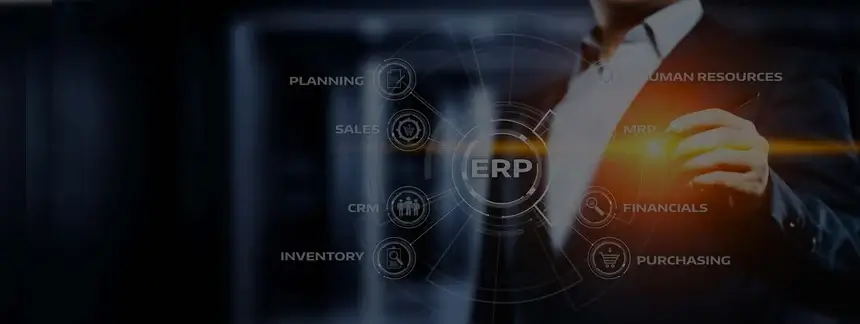ERP Data Security: 3 Familiar and Favorable Methods of Data Protection
Enterprise resource planning (ERP) systems have become the backbone of many organizations in today’s digital-first world with integrated platforms that streamline operations, enhance efficiency, and provide valuable insights into business processes.
There lurks, however, dangers in ERP reliance as the wealth of sensitive data stored in ERP systems makes them prime targets for cyber threats.
“Many companies’ enterprise resource planning systems, which house their most valuable data, are still too vulnerable,” reported McKinsey Digital last year. “ERP systems not only contain the crown jewels of the business—customer data, stock levels, order entries, production plans, and contract data—they also manage such essential financial processes as order to cash (OTC), and operational processes such as production planning and steering and cash collection and payments.”
Ensuring data security in ERP systems is no longer a choice, but a necessity.
Companies that implement a combination of three tried-and-true ERP data security measures – encryption, multi-factor authentication (MFA), and real-time monitoring -- can create a layered defense strategy to safeguard their ERP systems and the invaluable data they contain.
How Important is Data Security in ERP Systems?
Modern ERP security features are evolving and improving but at the same time, businesses feel more threatened than ever before.
The answer lies in the rapid digital transformation, especially since the start of the pandemic, with SAP reporting that in 2021 there were 10 billion IoT devices connected worldwide, and according to IDC, that number is expected to hit 55 billion by 2025.
“Many of these devices are part of companies’ Industrial Internet of Things (IIoT) networks – and as such, they typically feed data into a central ERP system,” said SAP. “These days, a modern cloud ERP is mission-critical to most businesses, helping to unify all business operations under a single system. Yet, this core feature may also be a weakness when it comes to cybersecurity, making it a one-stop portal into a lot of critical information.”
Data security in ERP systems is of paramount importance for several reasons:
-
-
- Confidential Information: ERP systems often contain sensitive data such as financial records, customer information, and proprietary business processes. A breach could lead to data theft, financial losses, and damage to a company's reputation.
- Regulatory Compliance: Many industries face strict regulations regarding data protection, such as FDA, GDPR, ITAR, CCPA, and others, and non-compliance can result in severe penalties. Proper data security ensures adherence to these regulations.
- Operational Continuity: Cyberattacks can disrupt business operations, causing downtime and financial losses. A secure ERP system helps maintain operational continuity.
- Customer Trust: Protecting customer data fosters trust and loyalty. Customers are more likely to do business with companies that safeguard their information.
- Confidential Information: ERP systems often contain sensitive data such as financial records, customer information, and proprietary business processes. A breach could lead to data theft, financial losses, and damage to a company's reputation.
-
Modern ERP and Software Security Challenges
SAP says the idea of building a secure perimeter around specific IT assets or databases and then limiting and controlling access is not effective in a cloud-connected ecosystem.
“In a cloud ERP environment, organizations are recalibrating their approach to security as they share more responsibility with public cloud providers, and therefore focus less on the infrastructure and more on the application-side responsibilities they continue to own,” says SAP.
Ransomware and phishing attacks present a rapidly growing challenge, noting metrics such as:
-
-
- A company is hit with a ransomware attack every 11 seconds in 2021.
- The average cost of recovering from a ransomware attack is $1.85 million.
- 43 percent of all data breaches involve small and medium businesses.
-
“While cyberattacks continue to be top of mind for executives, many may not fully appreciate how vulnerable their ERP systems are to such attacks. This could become a significant problem as evidence mounts of increasing threats targeting ERP systems,” says McKinsey Digital.
McKinsey Digital says protecting ERP systems data has the following unique challenges:
-
-
- ERP systems consist of a wide array of elements, including process and workflow, master data and data warehouse, an underlying computational infrastructure, a large storage network—and dozens if not hundreds of interfaces and integration points with other IT applications inside and outside of the organization.
- Companies often do not have global transparency into what’s happening in their ERP systems, from what data is passing through to what interfaces there are with various other systems to what transactions are happening.
- ERP systems have interconnections between internal applications and external data sources and systems, such as a supplier’s supply chain or logistics system.
- This interdependency issue is further compounded because the ERP group is often separate from the rest of the company’s applications and infrastructure teams.
- ERP systems consist of a wide array of elements, including process and workflow, master data and data warehouse, an underlying computational infrastructure, a large storage network—and dozens if not hundreds of interfaces and integration points with other IT applications inside and outside of the organization.
-
Making Your ERP System Secure with These Well-Established Tactics
There are well-established practices to secure your ERP data from cyberattacks with the three most-recognized as encryption, MFA, and real-time monitoring.
Let’s look at each three, and their advantages and disadvantages:
Encryption
How Encryption Protects Data: Encryption transforms data into an unreadable format using algorithms and cryptographic keys. Only authorized parties with the decryption key can access the data. It secures data both at rest (stored on servers or devices) and in transit (during data transmission).
Advantages of Encryption
-
-
- Data Confidentiality: Encrypting data ensures that even if unauthorized parties gain access to it, they cannot read or use it.
- Compliance: Encryption is often a requirement for compliance with data protection regulations.
- Data Integrity: It helps verify that data has not been tampered with.
-
Disadvantages of Encryption
-
-
- Complexity: Implementing and managing encryption can be complex and may require specialized expertise.
- Performance Overhead: Encryption processes can introduce a performance overhead, slowing down data access and transmission.
- Key Management: Safeguarding encryption keys is critical; if lost, data may become inaccessible.
-
Multi-factor Authentication (MFA)
How MFA Protects Data: MFA adds an additional layer of security beyond just a password. Users must provide two or more forms of verification, such as something they know (password), something they have (a token or smartphone), or something they are (fingerprint or facial recognition).
Advantages of MFA
-
-
- Enhanced Security: MFA makes it significantly more challenging for unauthorized users to access ERP systems, even if they have stolen or guessed passwords.
- Reduced Unauthorized Access: It reduces the risk of unauthorized access due to stolen or compromised credentials.
- Compliance: MFA is often a requirement for compliance with security standards and regulations.
-
Disadvantages of MFA:
-
-
- User Friction: Some users may find MFA processes cumbersome or time-consuming.
- Implementation Complexity: Setting up MFA for all users and devices can be complex, especially in large organizations.
- Cost: Implementing MFA may involve additional costs for hardware tokens or software licenses.
-
Real-Time Monitoring
How Real-Time Monitoring Protects Data: Real-time monitoring continuously analyzes system and network activities for suspicious or unauthorized behavior. It can identify and respond to security threats as they occur, preventing data breaches.
Advantages of Real-Time Monitoring
-
-
- Early Threat Detection: It identifies threats as they happen, allowing for rapid response and mitigation.
- Incident Management: Real-time monitoring provides valuable data for incident investigation and management.
- Continuous Improvement: Monitoring helps organizations continuously improve their security posture based on real-world threats.
-
Disadvantages of Real-Time Monitoring
-
-
- Resource Intensive: Real-time monitoring requires significant computing resources and may impact system performance.
- Complexity: Implementing and configuring monitoring systems can be complex and require skilled personnel.
- False Positives: Monitoring systems may generate false alarms, leading to wasted time and resources.
-
Data security in ERP systems is a non-negotiable element of modern business operations.
The three methods discussed—encryption, MFA, and Real-time monitoring—offer robust protection for sensitive data.
Each has its advantages and disadvantages, and the choice of method depends on the specific needs and constraints of your organization.
By implementing a combination of these methods, organizations can create a multi-layered defense strategy that safeguards their ERP systems and the invaluable data they contain, ensuring business continuity and maintaining the trust of stakeholders.
Is data security a concern in your organization? We welcome a discussion about this critical factor and how you may best approach implementing these methods to help mitigate growing security risks.

